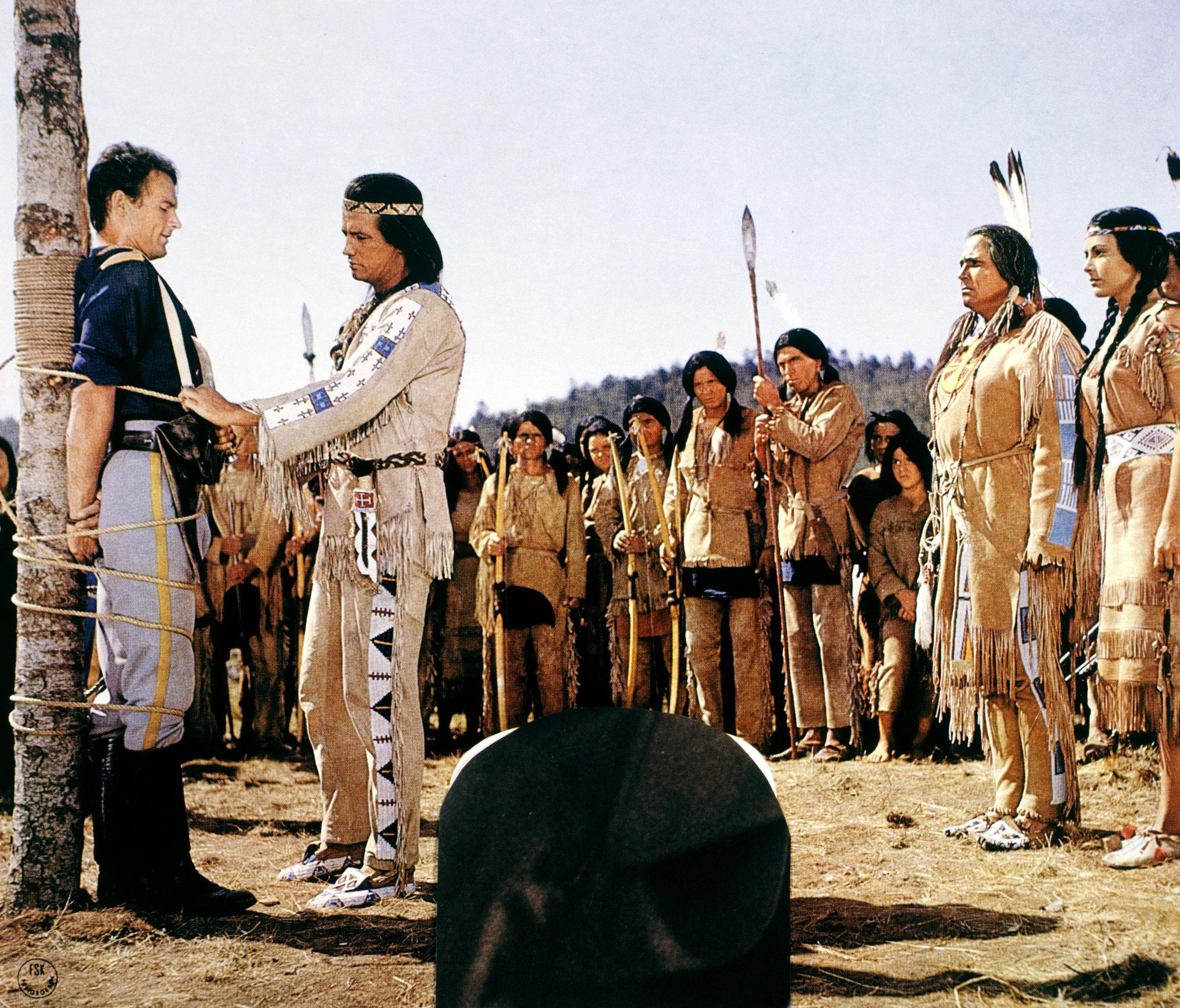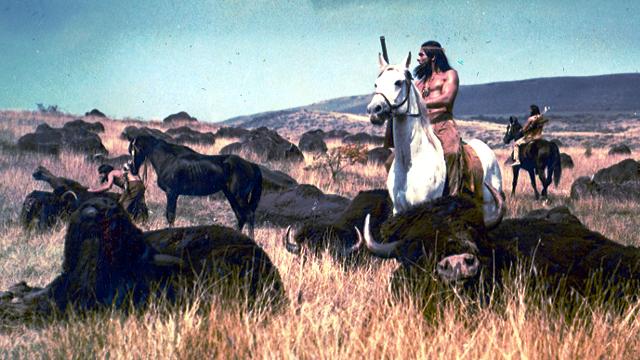Kategorie: Background in English
Winnetou and his Red Brothers
German "Indian Films" in West and East
In 1962, the success of "Der Schatz im Silbersee" ("Treasure of the Silver Lake") set off a Wild West craze in German cinema – first in West Germany, then in the East.

"Der Schatz im Silbersee" (Harald Reinl, BRD/YU/FR) was released in German cinemas in the Christmas season of 1962. Its success triggered a wave of what became known as "Indian Films", which swept first over West Germany, then East Germany. There were fundamental difference between the productions on each side of the iron Curtain but there were also similarities. While the West German films, mostly based on the novels of Karl May, inhabited a fairy-tale world of moral unambiguity, the East German movies attempted to achieve authenticity without contravening the Marxist view of history. But they, too, resorted to established patterns of the Hollywood Zum Inhalt: Western. The stereotypical "Indian" reflected the social order but also offered a projection screen for exotic fantasies.
Wild West Romance, Fairy Tales and Marxism
The success of "Der Schatz im Silbersee" was significant because West German cinema was in the commercial doldrums in the early 1960s. Horst Wendlandt, who produced it with the company Rialto Film, made eight more films, including the "Winnetou" Trilogy (1963-1965), "Unter Geiern" ("Among Vultures", Alfred Vohrer, BRD/FR 1964)1964) and "Der Ölprinz" ("The Oil Prince", Harald Philipp, BRD/YU 1965). The Berlin-based producer Artur Brauner also got in on the Karl May act with his company, CCC Film. He succeeded in securing the services of the main actors in Wendlant’s productions for "Old Shatterhand" (Hugo Fregonese, BRD/FR/IT 1964): Lex Barker as Old Shatterhand and Pierre Brice as Winnetou. The last movie in the "Winnetou" series, "Winnetou und Shatterhand im Tal der Toten" ("The Valley of Death", Harald Reinl, BRD/YI/IT 1968) was again produced by Brauner, after Rialto Film broke off the shooting. The star of "Der Schatz im Silbersee" had been the American Lex Barker, who had played Tarzan in a series of Hollywood films. But the Frenchman Pierre Brice as an Apache "chief" soon became the series’ trade mark. He was the face of the novel character Winnetou on the silver screen.
picture-alliance / KPA
In East Germany, on the other hand, the Karl May wave seemed to pass by unnoticed. After the construction of the Berlin Wall, the West appeared further away than ever. Karl May did not correspond with state ideology and was no longer published. But the cinemas of the ČSSR (Czechoslovakia) offered a glimpse of the screen icons of the western world and young people from East Germany, in particular, availed of this opportunity. Spurred on by the West German "Indian Films" and the need to answer it with its own version, the people’s film company DEFA produced "Die Söhne der Grossen Bärin" ("The Sons of Great Bear", Josef Mach, GDR 1966). The film, whose release coincided with a comprehensive wave of censorship of political films in East Germany, was based on a novel by the historian and writer Lieselotte Welskopf-Henrich. The model for the next film, "Chingachgook, die große Schlange" ("Chingachgook, the Great Serpent", Richard Groschopp, GDR 1967), which addressed the exploitation of the indigenous population, was provided by James Fenimore Cooper’s novel The Deerslayer (1841). This attention to historical precision and authentic props also characterized subsequent "DEFA Indian Films". Movies such as "Spur des Falken" ("The Trail of the Falcon", Gottfried Kolditz, GDR 1968), "Weiße Wölfe" ("White Wolves", Konrad Petzold, Boško Bošković, GDR/YU 1969), "Tödlicher Irrtum" ("Fatal Error", Konrad Petzold, GDR 1970), "Blutsbrüder" ("Blood Brothers", Werner W. Wallroth, GDR 1975), or "Atkins" (Helge Trimpert, GDR 1985) refer more or less accurately to concrete historical events.
In "Osceola" (Konrad Petzold, GDR 1971), "Tecumseh" (Hans Kratzert, GDR 1972), "Apachen" (Gottfried Kolditz, GDR 1973) and "Ulzana" (Gottfried Kolditz, GDR 1974), real historical characters are used as protagonists. "Blauvogel" ("Bluebird", Ulrich Weiß, GDR 1979) is about the fate of a boys growing up with Iroquois. Since it was loathe to use the term "Western", DEFA called its productions "historical adventure films in the milieu of the Indians". There was a star for these films, too, the Yugoslav Gojko Mitić, whose chiseled physique performed a similar emblematic role to the more gentle physiognomy of his western counterpart. Before that, Mitić had already played in four West German "Westerns".
Racist Clichés and Genre Conventions
The Winnetou and DEFA films had less to do with the real Native Americans than with the imaginations of the societies that produced them. It did not take much to show an authentic representation of an "Indian" on screen: a slightly darker skin type was enough, at least from the point of view of the filmmakers. In both German states, portrayal was based on racist clichés and Zum Inhalt: genre conventions. There were deviations from this pattern at DEFA, however. The main difference was on the narrative level: in the DEFA films, the violence is always started by the "White" invaders. Apachen, for example, shows a massacre of Native Americans by Euro-Americans and the subsequent scalping of victims by the murderers. In Chingachcook, too, it is the "Whites" who go on a scalping spree, in a historically accurate reversal of the "blood-thirsty savage".
Furthermore, many of the DEFA productions feature a portrayal of the daily life of the indigenous people. However, the extras engaged in crafts, making tools or cooking are always overshadowed by a single heroic figure, be it Tokeiihto, Ulzana, Osceola or Tecumseh. Another stereotype featured in both East and West Germany: whether "noble redskin" or "bloodthirsty scalp-hunter" – as a vanishing race the "Indians" are doomed by fate to die out. The voice-over commentary of "Der Schatz im Silbersee" calls it the "tragedy of a race rising up for the last time in the throes of death". The displacement, destruction of food chains, imported diseases and genocide wrought by the Europeans seemed almost like a natural development – in line with the doctrine of manifest destiny. Although the DEFA films aimed to expose these connections, they lapsed into the same thought patterns. There was no more space for indigenous cultures in the constantly progressing social order of dialectical materialism than in capitalism. It is no accident that the eponymous hero of Tecumseh, the historical leader of a multi-tribal confederacy, dies an allegoric death in the backlight of the setting sun.
DEFA-Stiftung/Waltraut Pathenheimer
The Karl May Zum Inhalt: adaptations in West Germany, on the other hand, mirrored American B Westerns. At least in commercial terms, they targeted international audiences and acted as a template for the – artistically more significant – Spaghetti Western. For West German post-war society, this imitation of Hollywood represented an attempt at rapprochement with the US. After the atrocities of National Socialism and the resultant – albeit suppressed – feelings of guilt, West German society believed it was on the right side again. The problems with this assumption were laid bare by the Frankfurt Auschwitz Trials (1963-1965), in which it became clear how deeply implicated West German society was in its Nazi past. The Winnetou movies countered this finding with simple stories and a clear distinction between good and evil. At the same time, they provided material for (youthful) dreams of a different life. These dreams collided in 1968, the year the last Karl May film, "Winnetou und Shatterhand im Tal der Toten", was released, with the concrete political demands of the student movement. And while Winnetou and his embodiment by Pierre Brice had been outlived as cinematic icons by social change, he had also inscribed himself on the collective consciousness of West Germany – and now appeared in a family setting on the smaller screen of the TV, to tell his tales of a moralized wilderness.
Scholarly Literature
Frayling, Christopher (1981): Spaghetti Westerns: Cowboys and Europeans from Karl May to Sergio Leone. London: Routledge and Kegan Paul.
Kilpatrick, Jacquelyn (1999): Celluloid Indians: Native Americans and Film. Lincoln, NE/London: University of Nebraska Press.
Rollins, Peter C./John E. Connor (Hg.) (1998): Hollywood's Indians: The Portrayal of the Native American in Film. Lexington, KY: The University of Kentucky Press.
Wehrstedt, Norbert (1996): Indianerwestern made in GDR. In: I. König, D. Wiedemann und L. Wolf (Hg.): Zwischen Marx und Muck: DEFA Filme für Kinder. Berlin: Henschel Verlag, 55-69.

